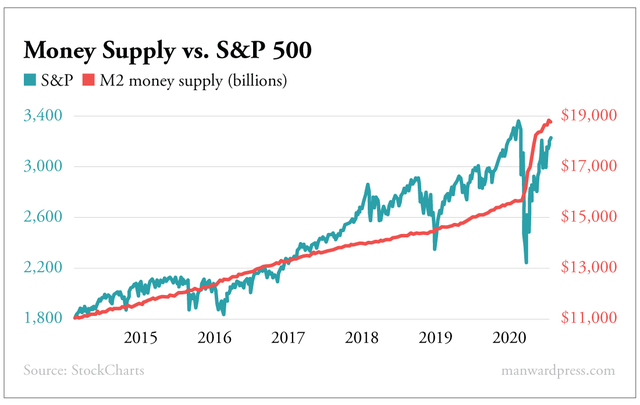This Chart Shows the Only Place the Fed’s Money Can Go
A few weeks ago, we had an intruder on the farm… and now we’ve got helicopters buzzing the tree line.
It’s proof that one mistake leads to another… and that one economic goof can lead to an explosion of mistakes.
This tale is one you’ll want to note.
You see, Mrs. Manward called us in a bit of a panic the other day. There was a small black helicopter circling our house. He was flying within feet of the ground, going back and forth… back and forth.
It got so close that she could see the pilot looking at her. He waved, cocked the stick to the left and zoomed off for another run, making our flag crack from the wind.
I told her not to worry. He was spraying the neighbor’s corn field.
“Didn’t he already spray twice?” she asked.
“Yes,” we replied. “But the first spray killed the weeds… the second spray fertilized what survived… and now this one is killing the diseases that ravage a crop after the field’s natural biology has been erased.”
It’s an endless cycle that lets few folks escape.
What’s happening in the fields around our farm is one of the hardest lessons learned in the world of farming… that a single tweak to the ground or the plants in it has massive effects on the entire cycle.
Fertilize a flower, for example, and it takes the easy route. Instead of trading minerals and nutrients with the microbes in the soil (which takes energy), it’d much rather drink in a rich concoction of chemicals.
It ditches its trade partners.
The flower grows great… but the microbes in the soil die.
All is fine, until the fertilizer stops or no longer works.
With that, we pivot to the topic du juor.
Stimulus… and its role in the markets.
Fertilizing the Economy
Just as it took the ag world decades to realize that one chemical begets another, the folks who write our economic textbooks are quickly learning that injecting money over here may have a profound effect way over there.
Take our Dow 100,000 theory, for example.
At the same time as we see some of the darkest headlines of our time – raging unemployment, soaring bankruptcies and plunging output – we’re predicting stocks will soar.
It’s not because we don’t believe the bad news.
We do.
In fact, we say the news will get worse before it gets better.
But we’ve been around the block a time or two. We’ve lived here. We’ve lived there. We’ve done this. And we’ve done that.
Through it all, we know that helicopter pilot has a job only because the fertilizer salesman did his.
One man kills the soil. Another brings it back.
It’s the same in the world of money.
Congress pushes here… the Fed pulls there.
Reams of regulations make it impossible for small businesses to survive… the Treasury mails the victims a $600 check each week.
Washington spends more than the world can lend… the Fed fires up its printing press.
Just like the fields above our house, the soil is all but dead and unable to thrive on its own… and yet the crop is lush and green – thanks to man and his many machines.
As long as the helicopters keep spraying, the corn will grow.
But what if the helicopter crashes? What if the fertilizer quits working? Or what if the old man writing the checks says enough is enough… and gets a steady job with Uncle Sam?
The crops will crash. The weeds will grow. And the money will stop flowing.
Someday, health would return. After a few painful decades, nature’s equilibrium would come again and the crops would be lush… but only until we started poking around again.
Helicopter Money
Now, we’re sure there are naysayers among our readers. We’re sure our ramblings haven’t convinced all that – like a heavy dose of fertilizer – the meddling in our economy is good for now… but will be hell down the road.
For those folks – the folks who are too scared to invest in a stake of this propped-up economy – we get it. But before you give up, we want to show you a chart.
It’s quite simple.
It depicts the action of the S&P 500 and the amount of money flowing through the economy (using M2 for all you monetary wonks).
 There is some healthy debate in the textbooks about the correlations on the left side of the chart. A rising stock market creates money of its own.
There is some healthy debate in the textbooks about the correlations on the left side of the chart. A rising stock market creates money of its own.
But there’s no debating that huge spike on the right in both the amount of money in the economy and the market’s moves over the last four months.
One surely led to the other.
With the crop threatening to die… the Fed took off in its helicopter and spread money all across the land. Trillions of dollars of freshly printed money made things green again.
But as we’ve learned, one dose of spray leads to another… which leads to another.
It takes us back to the headlines and what we’ve penned so many words about of late. Without further application, this crop will die.
Millions will be evicted. Companies will disappear. Retirements will go bust.
The old farmer doesn’t have a choice… He’s got to keep spraying.
Congress is now debating $1 trillion or $3 trillion.
And, as that chart so beautifully shows, the more it spends, the taller our stocks will grow.
All that money gushing out of the chopper must go somewhere.
It’s Dow 100,000… whether we like it or not.
About Andy Snyder
Andy Snyder is the founder of Manward Press. An American author, investor and serial entrepreneur, Andy cut his teeth at an esteemed financial firm with nearly $100 billion in assets under management. In the years that have followed, he’s become sought after for his outspoken market commentary.
Andy and his ideas have been featured on Fox News, on countless radio stations, and in numerous print and online outlets. He’s been a keynote speaker and panelist at events all over the world – from four-star ballrooms to Capitol hearing rooms – and has rubbed shoulders with lawmakers, lobbyists and Washington insiders. He’s had lunch with John McCain… fished with America’s largest landowner… and even appeared on the Christmas card of one of Hollywood’s top producers.
Today, Andy’s dissident thoughts on life, Liberty and investing can be found in his popular e-letter, Manward Financial Digest, as well as in the pages of Manward Letter. He also is at the helms of the award-winning VIP Trading Research Services Alpha Money Flow and Venture Fortunes. Andy resides on 40 bucolic acres in rural Pennsylvania with his wife, children and a steadily growing flock of sheep.






